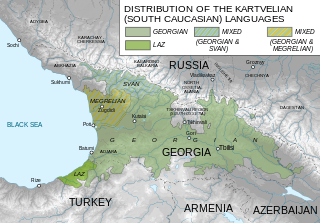Liparit II Dadiani (Georgian :ლიპარიტ II დადიანი; died 1512) was a member of the House of Dadiani and eristavi ("duke") of Odishi, that is, Mingrelia, in western Georgia from 1482 until his death.

Georgian is a Kartvelian language spoken by Georgians. It is the official language of Georgia. Georgian is written in its own writing system, the Georgian script. Georgian is the literary language for all regional subgroups of Georgians, including those who speak other Kartvelian languages: Svans, Mingrelians and the Laz.

The House of Dadiani was a Georgian family of nobles, dukes and princes, and a ruling dynasty of the western Georgian province of Samegrelo (Mingrelia) or Odishi.

Eristavi was a Georgian feudal office, roughly equivalent to the Byzantine strategos and normally translated into English as "duke". In the Georgian aristocratic hierarchy, it was the title of the third rank of prince and governor of a large province. Holders of the title were ex-officio commanders of a military 'banner', wore a distinctive dress, ring, belt and spear and rode a particular breed of horse.
Liparit was a son of Shamadavle Dadiani, eristavi of Odishi, by his wife, Anna. He succeeded on the death of his granduncle, Vameq II Dadiani, in 1482. In a multiparty civil war which plagued the crumbling Kingdom of Georgia at that time, Liparit maintained his predecessor's choice of supporting King Constantine II of Kartli against the rival prince, Alexander, who established himself as king of Imereti in 1484. Liparit invited Constantine to retake Imereti and aided him with his army to put Alexander into flight to the mountains of Racha in 1487. Next year, Constantine, attacked by the Ag Qoyunlu Turkomans in Kartli, was no more in a position to maintain himself in Imereti and Alexander was able to resume his reign. Liparit made peace with Alexander and continued to rule as his vassal, but with considerable autonomy. In 1491, Constantine II of Kartli reconciled himself with the fait accompli and recognized Alexander as king of Imereti, thereby consummating the dissolution of the Kingdom of Georgia. [1] [2] [3]
Shamadavle Dadiani was a member of the House of Dadiani and eristavi ("duke") of Odishi (Mingrelia) in western Georgia from 1470 until his death. He succeeded his father Liparit I Dadiani and continued his predecessors' efforts to garner more autonomy as the united Kingdom of Georgia was approaching to its end.
Vameq II Dadiani was a member of the House of Dadiani and eristavi ("duke") of Odishi (Mingrelia) in western Georgia from 1474 until his death.

The Kingdom of Georgia, also known as the Georgian Empire, was a medieval Eurasian monarchy which emerged circa 1008 AD. It reached its Golden Age of political and economic strength during the reign of King David IV and Queen Tamar the Great from 11th to 13th centuries. Georgia became one of the pre-eminent nations of the Christian East, her pan-Caucasian empire stretching, at its largest extent, from Eastern Europe and the North Caucasus to the northern portion of Iran and Anatolia, while also maintaining religious possessions abroad, such as the Monastery of the Cross in Jerusalem and the Monastery of Iviron in Greece. It was the principal historical precursor of present-day Georgia.
Liparit II died in 1512 and was succeeded by his son, Mamia III. He possibly had also a daughter, Gulnar, who was married to Prince Abash Abashidze. [4]
Mamia III Dadiani was a member of the House of Dadiani and eristavi ("duke") of Odishi, that is, Mingrelia, in western Georgia from 1512 until his death. Mamia was a son and successor of Liparit II Dadiani, who had emerged as a semi-independent ruler in the process of dissolution of the Kingdom of Georgia. Mamia was culturally active in Abkhazia and continued his predecessors' efforts to secure borders against the North Caucasian mountainous tribes of Zygia. His naval expedition against them and landing in Zygia ended in a fiasco and Mamia was killed in battle.

The Abashidze is a Georgian family and a former princely house. Appearing in the 15th century, they achieved prominence in the Kingdom of Imereti in western Georgia in the late 17th century and branched out in the eastern Georgian kingdoms of Kakheti and Kartli as well as the then-Ottoman-held southwestern region of Adjara. After the Russian annexation of Georgian polities, the family was confirmed as Knyaz Abashidze by the Tsar’s decree of 1825.



